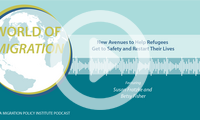International Students
Recent Activity
Marking the launch of MPI’s Global Skills and Talent Initiative, this webcast features senior policymakers and other experts discussing the extent to which labor market needs should shape future immigration policy decisions, and how countries are adjusting—and could adjust—their immigration systems to meet human capital and competitiveness needs.

How could humanitarian migrants with skills and experience use existing work or study visa pathways to fill labor market needs in destination countries? MPI’s Susan Fratzke speaks with Betsy Fisher, U.S. Director of the nonprofit Talent Beyond Boundaries, about complementary pathways as an innovative addition to refugee resettlement and asylum.
On the sidelines of the Ninth Summit of the Americas, this event co-sponsored by MPI examines tools and concrete actions taken on regional migration governance, best practices and lessons learned, and the role of regional mechanisms to respond to migration and forced displacement.
At the 15th annual Immigration Law and Policy Conference, held in October 2018, leading experts and government officials discussed the role that immigration is playing in the mid-term elections; how the courts are handling key immigration questions; and recent changes in the U.S. asylum system, border and interior enforcement, and regulations surrounding legal immigration.



















Investing in the Future: Higher Ed Should Give Greater Focus to Growing Immigrant-Origin Student Population
Canada's New Tech Talent Strategy Takes Aim at High-Skilled Immigrants in the United States